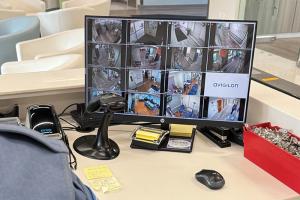Health care facilities step up efforts to prevent workplace violence

A visitor checks in at the Sentara Norfolk General Hospital Kaufman Lobby to receive a visitor badge.
Image courtesy of Sentara Healthcare
Health care workers are five times more likely to experience a workplace violence injury than all other workers, according to data released in 2020 from the Bureau of Labor Statistics. This places great strain on the health care delivery system, as violence has a lasting impact on the workforce, often resulting in psychological distress, higher job dissatisfaction and turnover. It also impedes clinicians’ ability to provide high-quality patient care.
In response, hospitals and health systems are stepping up efforts to ensure workplace safety. Through comprehensive violence prevention programs and heightened access and security measures, hospitals are working to turn the tide on this disturbing trend.
For many patients and visitors, this means the next visit to the hospital or clinic may resemble attending a concert or sporting event. To increase security and enhance access control, some hospitals and health systems are adopting badging and weapon detection systems like those used at public event venues.
Duke University Health System, based in Durham, N.C., installed weapons detection systems at the main public entrances to its three hospitals earlier this year. While metal screenings have been in place in the organization’s emergency departments for several years, the expansion seeks to enforce its weapons-free campus policy.
Patients and visitors can pass through the devices without having to empty pockets and bags or remove their belts, while staff with badges can bypass the screenings. Signage alerts visitors to the process and reminds them to leave their weapons behind or they will be confiscated. Visitors who do not comply will not be allowed to enter the building. Other enhanced security measures at Duke include additional emergency alert support to care teams and posted signage that aggressive behavior will not be tolerated.
A high-level threat assessment at Sentara Healthcare in Norfolk, Va., identified access control as a top safety concern.
“Nobody knew who was supposed to be in the building and why,” says Stephen Hollowell, Sentara’s senior director of systemwide security. In response, the organization has rolled out a new badging system across all 12 Sentara hospitals.
All visitors must stop and check in with reception for a personalized badge. Visitors must show a photo ID and tell the receptionist their destination in the building. Visitors will have their photo taken for printing on a visitor badge they must wear at all times. Individuals spotted without a badge are instructed to visit the registration desk to receive one. Sentara does make exceptions for visitors who do not have a photo ID or are culturally averse to having their photo taken, says Samantha Kern, Sentara’s director of patient care services.
“We believe this system is necessary to keep staff, patients and visitors safe,” Hollowell says. The system is working, he adds. People who were flagged in the system for previous bad behavior have been denied entry.
Increased reports of violence from member organizations prompted the Massachusetts Health and Hospital Association (MHA) to form a multidisciplinary work group six years ago to better understand the risks and develop best practices to address workplace violence. According to a January 2023 MHA report, employees in Massachusetts health care facilities experience abusive incidents, including physical assault, verbal abuse or threats, every 38 minutes.
MHA began conducting a monthly survey in 2020 that tracks the frequency, location and types of violence committed on hospital campuses. Hospital CEOs receive hospital-specific findings as well as overall survey results to help develop safe work environments.
The results have led to the implementation of numerous best practices in hospitals across the state, including expanded training programs, the use of emergency response teams to de-escalate potential events and the development of a patient code of conduct that sets clear expectations for patient and visitor behavior.
“There are many resources available to health care organizations to help address workplace violence,” says Patricia Noga, MHA’s vice president of clinical affairs. “It’s important to share best practices and experiences to ensure safety for our employees, patients and families.”




